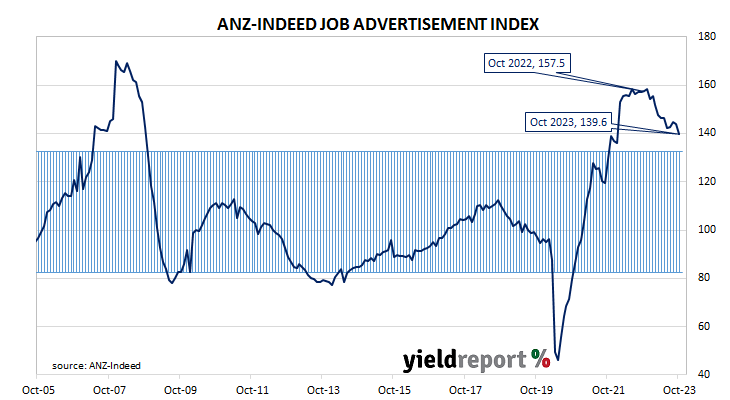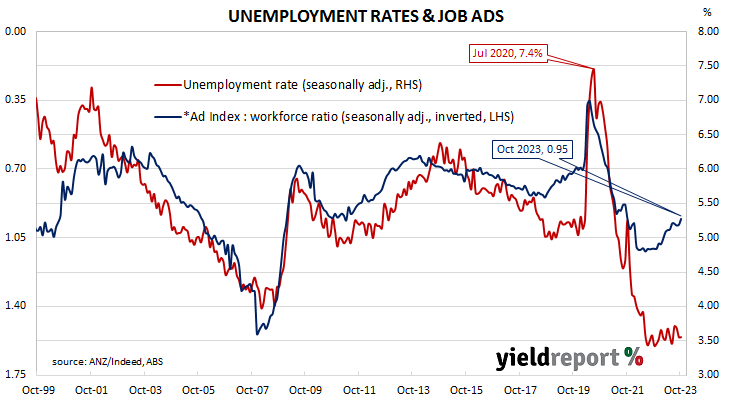Summary: Job ads down 3.0% in October; 11.4% lower than October 2022; ANZ: down 3.5% over last 2 months; short-term ACGB yields slip, longer-term yields barely move; rate-rise expectations soften slightly; ANZ: slack slowly creeping into labour market, jobless rate will rise further; ad index-to-workforce ratio falls to 0.95.
From mid-2017 onwards, year-on-year growth rates in the total number of Australian job advertisements consistently exceeded 10%. That was until mid-2018 when the annual growth rate fell back markedly. 2019 was notable for its reduced employment advertising and this trend continued into the first quarter of 2020. Advertising plunged in April and May of 2020 as pandemic restrictions took effect but then recovered quite quickly, reaching historically-high levels in 2022.
According to the latest ANZ-Indeed figures, total advertisements lost 3.0% in October on a seasonally adjusted basis. The result followed a loss of 0.5% in September and a gain of 1.4% in August. On a 12-month basis, total job advertisements were 11.4% lower than in October 2022, down from September’s revised figure of -8.5%.
“ANZ-Indeed Australian Job Ads has declined 3.5% over the last two months, taking the series to its lowest level since January 2022,” said ANZ economist Madeline Dunk. “The number of job ads, however, is still elevated compared to historical levels.”
Short-term Commonwealth Government bond yields slipped a touch while longer-term yields barely moved on the day, ignoring overnight falls of US Treasury yields. By the close of business, the 3-year ACGB yield had ticked down 1bp to 4.209%, the 10-year yield had returned to its starting point at 4.74% while the 20-year yield finished 2bps higher at 5.06%.
In the cash futures market, expectations regarding further rate rises softened slightly. At the end of the day, contracts implied the cash rate would increase from the current rate of 4.07% and average 4.195% through November, 4.275% in December and 4.355% in February. May 2024 contracts implied a 4.45% average cash rate while August 2024 contracts implied 4.44%, 37bps more than the current rate.
“Slack is slowly creeping into the labour market. Hours worked have been falling, recent jobs growth has been driven by part-time employment, youth unemployment has been rising and the underemployment rate has been moving up,” Dunk added. “This, along with the modest unwinding in job ads numbers, suggests the unemployment rate will rise further.”
The inverse relationship between job advertisements and the unemployment rate has been quite strong (see below chart), although ANZ themselves called the relationship between the two series into question in early 2019. A higher job advertisement index as a proportion of the labour force is suggestive of lower unemployment rates in the near future while a lower ratio suggests higher unemployment rates will follow. October’s ad index-to-workforce ratio fell from 0.98 to 0.95 after revisions.
In 2008/2009, advertisements plummeted and Australia’s unemployment rate jumped from 4% to nearly 6% over a period of 15 months. When a more dramatic fall in advertisements took place in April 2020, the unemployment rate responded much more quickly.



